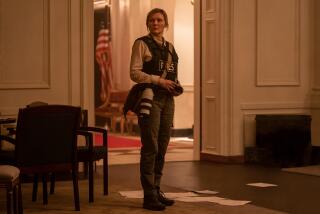Blood, sweat and fear in the Pacific
- Share via
John Dahl’s World War II saga “The Great Raid” begins with a lengthy, painstaking preamble to a lengthy, painstaking reenactment of the raid on Cabanatuan. Rings no bells? Not to worry. Based on two books, “The Great Raid on Cabanatuan” by William B. Breuer and “Ghost Soldiers” by Hampton Sides, the movie will dutifully spackle over every last gap in your education and even allow for dry time.
Meanwhile, the hand of the guy who directed such dexterous neo-noirs as “Red Rock West” and “The Last Seduction” is nowhere in evidence. A plodding, squeaky-straight Time-Life tribute to the greatest generation, the movie plays like a commemorative plaque. When Capt. Prince (James Franco) remarks early on that the 6th Ranger Battalion, which eventually carries out the rescue, is “exceptionally well-trained but has seen little action,” you’ll come to understand exactly what he means.
The setup begins shortly after Pearl Harbor, when Japan’s attack on the Philippines resulted in “the largest single defeat in the history of the American military” and the capture of 60,000 U.S. troops. Those who survived the Bataan death march were herded into Japanese prison camps, where they faced certain death.
The story begins three years later (about as long, incidentally, as “The Great Raid” moldered on Miramax’s shelves), when Col. Mucci (Benjamin Bratt) decides to stage a rescue mission that has no strategic value to the war. This fact is reiterated to the point of counterproductiveness, making him seem as though he sees “The Great Raid” more like The Big Favor. Mucci puts Capt. Prince in charge of planning so he may focus on stalking around commandingly, reeking of Clark Gable.
Divided three ways among the rangers, the prisoners and the resistance fighters in Manila, the movie feels unfocused, schematic and overpopulated. Among the captured is Maj. Gibson (Joseph Fiennes), who, ill with malaria, spends most of the movie supine, sweating and shivering. In his spare time, he pines chastely for Margaret Utinsky (Connie Nielsen), the beautiful widow of his commanding officer and the head of the resistance movement, who nobly pines back while smuggling quinine into the camp in the face of unspeakable danger.
Actually, that’s not true. The danger is speakable. There is very little in “The Great Raid” that isn’t explained in great depth. For roughly 45 minutes, characters manfully mumble shop -- outlining strategy, reiterating concerns and fretting over Japanese plans for prisoner annihilation against great symphonic swells. By the time the climax approaches, it hits you that you barely know who any of these soldiers are. Apart from Capt. Redding (Marton Csokas), Gibson’s rebel jokester friend, the prisoners and soldiers are called upon to do little more than look heroic, stoic and more or less Paleozoic when compared with characters in war-themed movies filmed after the late 1960s. Cinematographer Peter Menzies Jr. bleeds the color out of the footage, making it look like lightly colorized black-and-white. It’s a pretty effect, and fittingly old-fashioned for a movie uninterested in gray areas or the messy business of character.
*
‘The Great Raid’
MPAA rating: R for strong war violence and brief language
Times guidelines: Contains some violence, although it’s fairly tame by the standards of the genre
A Miramax Films release. Director John Dahl. Screenplay Carlo Bernard and Doug Miro, based on books by William B. Breuer and Hampton Sides. Producers Marty Katz, Lawrence Bender. Director of photography Peter Menzies Jr. Editors Pietro Scalia, Scott Chestnut. Production designer Bruno Rubeo. Music Trevor Rabin. Costume designer Lizzy Gardiner. Running time: 2 hours, 12 minutes.
In general release.
More to Read
Only good movies
Get the Indie Focus newsletter, Mark Olsen's weekly guide to the world of cinema.
You may occasionally receive promotional content from the Los Angeles Times.










